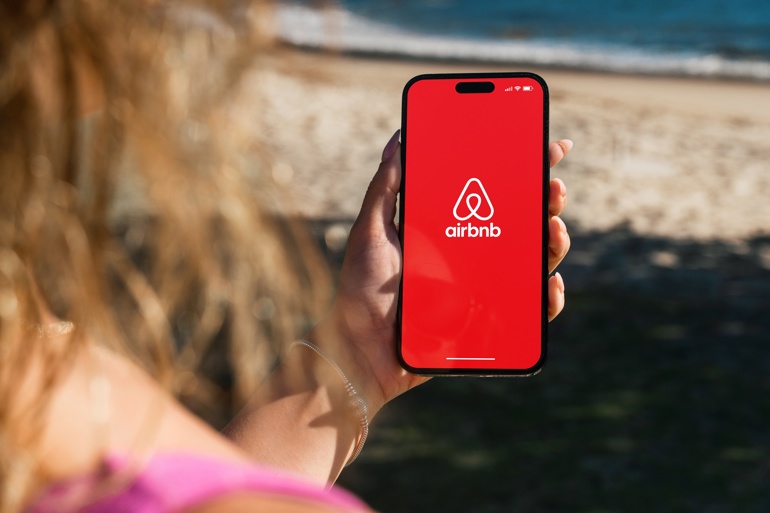The onboarding experience
One of Airbnb’s best UX achievements is the effortless onboarding process for both guests and hosts.
You’ve probably booked something on Airbnb by now, especially if staycationing was your chosen coping method during the pandemic. If you haven’t, the process is straightforward:
- Create an account using Google, Apple or email.
- Use guided search filters that help you find the perfect stay.
- Scroll through personalised recommendations based on previous interactions.
For hosts, Airbnb makes it easy to list a property through:
- Step-by-step listing guides with prompts to reduce your time thinking about what to write.
- Dynamic pricing suggestions to optimise earnings.
- Easy photo uploads to showcase properties effectively.
By omitting unnecessary barriers, Airbnb encourages more users to complete sign-ups and make bookings, directly impacting its conversion rates and brand growth.
Intuitive search and filters
Airbnb lists millions of accommodation options worldwide, so it relies on a highly effective search and filtering system to enhance usability and make it easier for people to find exactly what they’re looking for.
- Smart filters: Users can filter by price, location, amenities, cancellation policies and even more specific categories like Tiny Homes or Castles for people looking for a quirky stay.
- Map-based search: A visual interactive map helps users find stays in specific areas, so they can find a place that’s closer to the town centre or the beach if that’s what they want.
- Personalised suggestions: Airbnb’s AI-driven algorithms analyse user behaviour to provide tailored recommendations.
Building trust
We know how important it is for consumers to have trust in the brand they’re giving their money to; see Nike. Airbnb has made use of UI elements and UX principles to build credibility and promise safe transactions.
Verified reviews
Before booking, users can view detailed guest reviews with photos and verified stays. Their star-rating system makes it easy to compare properties without having to go through to a different page every time and read a write-up.
Host and guest verification
Airbnb encourages ID verification, linking profiles to social media and requiring profile photos, to avoid people fearing that they’re being catfished or scammed.
Secure payments
Airbnb’s checkout process ensures secure transactions, giving users peace of mind when booking accommodations.
These UX/UI choices have strengthened Airbnb’s brand reputation as a reliable and safe platform, encouraging us to use it again when we next go on holiday.
Mobile-first design
With over 50% of bookings made on mobiles, it’s clear that Airbnb prioritises mobile-first design to make sure the consumer experience is smooth on any screen size.
- Intuitive navigation: The navigation of the app is pretty foolproof; no-nonsense, nothing confusing, just swiping and tapping. It’s that easy.
- Fast load times: Airbnb’s streamlined UI reduces lag, meaning no one’s waiting around.
- Push notifications: Users receive timely booking updates and special offers, increasing engagement.
Emotional design
Beyond functionality, Airbnb’s design team make sure their UX/UI evokes emotion, a huge element in brand success.
- High-quality visuals: Large, vibrant photos immerse users in potential stays.
- Storytelling UI: Listings include personal host narratives, making experiences feel authentic and human.
- Minimalist design: Airbnb’s UI uses simple design, whitespace, soft typography and a calm colour scheme to create a premium feel.
Continuous innovation and A/B testing
Airbnb doesn’t get too comfortable just because it’s the leader of its field; it constantly refines its UX/UI through user feedback and data-driven testing.
- A/B testing: Airbnb frequently tests design changes, from button placements to search algorithms.
- Data-driven decisions: Every UX update is based on behavioural analytics, helping Airbnb curate the best possible user journey for both hosts and guests.
- New features: Airbnb introduces features like Experiences and AirCover to enhance the platform.
The commitment to design improvements keeps Airbnb ahead of the market competition and aligned with evolving user expectations.
Airbnb’s whirlwind rise to the top in the travel industry isn’t an accident, it’s the result of a meticulously curated user experience that prioritises convenience, trust and engagement. By refining every step of the user journey, Airbnb has built a brand that travellers love and use time and again.
For businesses aiming to stand out in competitive markets, investing in UX/UI design is an absolute non-negotiable. Whether you’re in tech, eCommerce, education or finance, an intuitive and user-focused digital experience can elevate your brand, conversions, consumer experience and consumer loyalty.
If you're interested in app design and how it can make or break the success of a brand, check out our developer courses.




